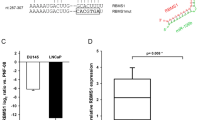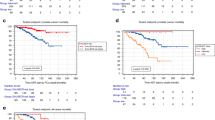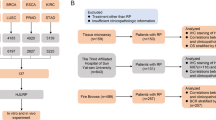Abstract
Control of cell proliferation by Polycomb group proteins (PcG) is an important facet of cellular homeostasis and its disruption can promote tumorigenesis. We recently described CBX7 as a novel PcG protein controlling the growth of normal cells. In an attempt to identify a putative role of CBX7 in tumorigenesis, we analysed CBX7 expression in a panel of cancer cell lines and primary tissues. CBX7 was highly expressed in three different prostate cancer cell lines and present at elevated levels in normal prostate. Ablation of CBX7 expression using short hairpin RNAs (shRNA) resulted in upregulation of p16Ink4a and p14Arf in both LNCaP and PC-3 prostate cell lines. CBX7 knockdown caused an impairment of cell growth that was dependent on the status of the p14Arf/p53 and p16Ink4a/Rb pathways in both normal and cancer prostate cells. CBX7 overexpression in LNCaP cells resulted in a slight growth advantage in both androgen-dependent and -independent conditions. Moreover, CBX7 expression cooperated with c-Myc in rendering LNCaP cells insensitive to growth arrest by androgen receptor inhibition. Together, these data suggest that CBX7 represses p16Ink4a and p14Arf expression in normal and tumor-derived prostate cells, affecting their growth depending on the status of the p16Ink4a/Rb and the p14Arf/p53 pathways.
This is a preview of subscription content, access via your institution
Access options
Subscribe to this journal
Receive 50 print issues and online access
$259.00 per year
only $5.18 per issue
Buy this article
- Purchase on Springer Link
- Instant access to full article PDF
Prices may be subject to local taxes which are calculated during checkout





Similar content being viewed by others
Change history
17 October 2022
This article has been retracted. Please see the Retraction Notice for more detail: https://doi.org/10.1038/s41388-022-02502-8
References
Abate-Shen C and Shen MM . (2000). Genes Dev., 14, 2410–2434.
Baylin SB and Herman JG . (2000). Trends Genet., 16, 168–174.
Bea S, Tort F, Pinyol M, Puig X, Hernandez L, Hernandez S, Fernandez PL, van Lohuizen M, Colomer D and Campo E . (2001). Cancer Res., 61, 2409–2412.
Bernard D, Pourtier-Manzanedo A, Gil J and Beach DH . (2003). J. Clin. Invest., 112, 1724–1731.
Bracken AP, Pasini D, Capra M, Prosperini E, Colli E and Helin K . (2003). EMBO J., 22, 5323–5335.
Cao R, Wang L, Wang H, Xia L, Erdjument-Bromage H, Tempst P, Jones RS and Zhang Y . (2002). Science, 298, 1039–1043.
Carroll AG, Voeller HJ, Sugars L and Gelmann EP . (1993). Prostate, 23, 123–134.
Chi SG, deVere White RW, Muenzer JT and Gumerlock PH . (1997). Clin. Cancer Res., 3, 1889–1897.
Drayton S, Rowe J, Jones R, Vatcheva R, Cuthbert-Heavens D, Marshall J, Fried M and Peters G . (2003). Cancer Cell, 4, 301–310.
Feldman BJ and Feldman D . (2001). Nat. Rev. Cancer, 1, 34–45.
Francis NJ and Kingston RE . (2001). Nat. Rev. Mol. Cell. Biol., 2, 409–421.
Futreal PA, Coin L, Marshall M, Down T, Hubbard T, Wooster R, Rahman N and Stratton MR . (2004). Nat. Rev. Cancer, 4, 177–183.
Gil J, Bernard D, Martinez D and Beach D . (2004). Nat. Cell Biol., 6, 67–72.
Hanahan D and Weinberg RA . (2000). Cell, 100, 57–70.
Hudson DL, O'Hare M, Watt FM and Masters JR . (2000). Lab. Invest., 80, 1243–1250.
Jacobs JJL and van Lohuizen M . (2002). Biochim Biophys Acta (BBA) Rev. Cancer, 1602, 151–161.
Jones PA . (2002). Oncogene, 21, 5358–5360.
Kanno M, Hasegawa M, Ishida A, Isono K and Taniguchi M . (1995). EMBO J., 14, 5672–5678.
Kasibhatla S, Brunner T, Genestier L, Echeverri F, Mahboubi A and Green DR . (1998). Mol. Cell, 1, 543–551.
Kirmizis A, Bartley SM and Farnham PJ . (2003). Mol. Cancer Ther., 2, 113–121.
Kirmizis A, Bartley SM, Kuzmichev A, Margueron R, Reinberg D, Green R and Farnham PJ . (2004). Genes Dev., 18, 1592–1605.
Kleer CG, Cao Q, Varambally S, Shen R, Ota I, Tomlins SA, Ghosh D, Sewalt RGAB, Otte AP, Hayes DF, Sabel MS, Livant D, Weiss SJ, Rubin MA and Chinnaiyan AM . (2003). Proc. Natl. Acad. Sci. USA, 100, 11606–11611.
Kuzmichev A, Nishioka K, Erdjument-Bromage H, Tempst P and Reinberg D . (2002). Genes Dev., 16, 2893–2905.
Lessard J and Sauvageau G . (2003). Nature, 423, 255–260.
Lu S, Tsai SY and Tsai MJ . (1997). Cancer Res., 57, 4511–4516.
Lund AH and van Lohuizen M . (2004). Curr. Opin. Cell Biol., 16, 239–246.
Muyrers-Chen I and Paro R . (2001). Biochim. Biophys. Acta (BBA) Rev. Cancer, 1552, 15–26.
Nelson WG, De Marzo AM and Isaacs WB . (2003). N. Engl. J. Med., 349, 366–381.
Nupponen NN, Kakkola L, Koivisto P and Visakorpi T . (1998). Am. J. Pathol., 153, 141–148.
Otte AP and Kwaks TH . (2003). Curr. Opin. Genet. Dev., 13, 448–454.
Pasini D, Bracken AP and Helin K . (2004). Cell Cycle, 3, 396–400.
Porkka KP and Visakorpi T . (2004). Eur. Urol., 45, 683–691.
Raaphorst FM, van Kemenade FJ, Blokzijl T, Fieret E, Hamer KM, Satijn DP, Otte AP and Meijer CJ . (2000). Am. J. Pathol., 157, 709–715.
Satijn D, Olson D, van der Vlag J, Hamer K, Lambrechts C, Masselink H, Gunster M, Sewalt R, van Driel R and Otte A . (1997). Mol. Cell. Biol., 17, 6076–6086.
Tokimasa S, Ohta H, Sawada A, Matsuda Y, Kim JY, Nishiguchi S, Hara J and Takihara Y . (2001). Exp. Hematol., 29, 93–103.
van Kemenade FJ, Raaphorst FM, Blokzijl T, Fieret E, Hamer KM, Satijn DP, Otte AP and Meijer CJ . (2001). Blood, 97, 3896–3901.
Varambally S, Dhanasekaran SM, Zhou M, Barrette TR, Kumar-Sinha C, Sanda MG, Ghosh D, Pienta KJ, Sewalt RGAB, Otte AP, Rubin MA and Chinnaiyan AM . (2002). Nature, 419, 624–629.
Visakorpi T . (2003). Urology, 62, 3–10.
Visakorpi T, Kallioniemi AH, Syvanen AC, Hyytinen ER, Karhu R, Tammela T, Isola JJ and Kallioniemi OP . (1995). Cancer Res., 55, 342–347.
Visser HP, Gunster MJ, Kluin-Nelemans HC, Manders EM, Raaphorst FM, Meijer CJ, Willemze R and Otte AP . (2001). Br. J. Haematol., 112, 950–958.
Wang J, Xie LY, Allan S, Beach D and Hannon GJ . (1998). Genes Dev., 12, 1769–1774.
Wang L, Brown JL, Cao R, Zhang Y, Kassis JA and Jones RS . (2004). Mol. Cell, 14, 637–646.
Zindy F, Eischen CM, Randle DH, Kamijo T, Cleveland JL, Sherr CJ and Roussel MF . (1998). Genes Dev., 12, 2424–2433.
Acknowledgements
We thank members of D Beach laboratory for helpful suggestions and discussion. Cancer Research UK supported this investigation. Part of this work was supported by the Spanish MCyT (project BIO2001-0069) to AC. JG and DB are recipients of a long-term fellowship from HFSP and a Marie Curie Intra-European fellowship, respectively.
Author information
Authors and Affiliations
Corresponding author
Additional information
Supplementary Information accompanies the paper on the Oncogene website (http://www.nature.com/onc)
Supplementary information
About this article
Cite this article
Bernard, D., Martinez-Leal, J., Rizzo, S. et al. RETRACTED ARTICLE: CBX7 controls the growth of normal and tumor-derived prostate cells by repressing the Ink4a/Arf locus. Oncogene 24, 5543–5551 (2005). https://doi.org/10.1038/sj.onc.1208735
Received:
Revised:
Accepted:
Published:
Issue Date:
DOI: https://doi.org/10.1038/sj.onc.1208735
Keywords
This article is cited by
-
CBX7 binds the E-box to inhibit TWIST-1 function and inhibit tumorigenicity and metastatic potential
Oncogene (2020)
-
Mammalian CBX7 isoforms p36 and p22 exhibit differential responses to serum, varying functions for proliferation, and distinct subcellular localization
Scientific Reports (2020)
-
Targeting epigenetic modifications in cancer therapy: erasing the roadmap to cancer
Nature Medicine (2019)
-
Bcor loss perturbs myeloid differentiation and promotes leukaemogenesis
Nature Communications (2019)
-
Targeting protein methylation: from chemical tools to precision medicines
Cellular and Molecular Life Sciences (2019)



